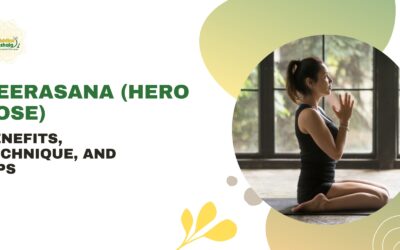Introduction – Vrksasana
Vrksasana or Tree pose is a balancing asana that is taught to yoga beginners because it’s simple. This asana teaches you to feel rooted like a tree and, at the same time, stand tall like one as well. With Vrksasana you’ll feel grounded through the strength of the leg you are standing on.
Bringing the sole of your right foot to your left shin or thigh can challenge your stability. And if you continuously move your legs, ankles, and core, you’ll find out that your body makes tiny movements to keep you stable.
The Tree yoga pose strengthens your glutes, legs, back, and core, which improves your alignment and posture. This is helpful if you have a sedentary lifestyle. Also, this pose allows you to find out how well-connected your body is and how well you can balance yourself. One day your foot is all the way up to your groin and on the other it might be partially on the ground. Don’t worry. It’s all about being aware of your limits and honoring your body.
Now, let’s look at some of the benefits of Vrksasana.

Benefits of Tree Pose (Vrksasana Benefits)
Tree pose benefits include improved balance, better posture, and increased concentration. Let us discuss Vrikshasana benefits as below:
- The pose in yoga is a strengthening posture that helps in building confidence.
- The pose in yoga improves posture and counters the effects of prolonged sitting.
- The pose in yoga strengthens the glutes, thighs, and ankles of the leg you are standing on.
- It stretches the entire glute and thigh of the lifted leg.
- The Tree yoga pose strengthens the core
- The Tree pose asana stretches your back and shoulders
How to Perform the Tree Yoga Pose?
- First, stand in Tadasana or Mountain Pose
- Spread your toes and press your feet firmly into the ground so that you can feel your leg muscles
- Lift your front hip point in the direction of your lower ribs and at the same time, lift your lower belly gently
- Take a deep breath, lift your chest, exhale and bring your shoulder blades back. Keep your gaze in the front fixed on a spot
- Your hands should be on your hips with your right foot on your left shin air thigh. Don’t place your right foot on the left knee
- Push both legs into each other
- Your pelvis should be leveled and toward the front
- When the stance feels steady, put your hands in Anjali Mudra and stretch your arms toward the ceiling like the branches of a tree
- Hold the pose for a few seconds, go back to Mountain Pose, and then switch sides
Also Read – Tadasana: Mastering the Mountain Pose for Optimal Posture and Balance
Tips for Beginner
Stand a few inches away from a wall on the side of the straight leg while practicing the Tree yoga pose. This grants you the confidence to stand tall even if you are not touching the wall. And in case you lose your balance, you can reach out and take support from the wall.
To avoid wobbling and losing balance in the Tree pose yoga, you have to be aware of the openness of your hips. If your hips are not open as they should be, your pelvis will twist and it will pull you out of balance. While you are doing this pose, your hips should be facing forward and level. Practice a few simple hip-opening asanas before you do this pose. It will open up your hips and you will be good at Tree pose. It’s a win-win.
- When you stretch your arms toward the ceiling, keep your biceps aligned with your ears. If you stretch your arms too far back, it might throw you off balance and you might fall backward.
- Think of yourself as a tree. Imagine that your feet are the roots, your lower and upper torso is a strong trunk, and your arms are branches.
- Don’t turn the foot of your standing leg. This can throw your knee and hip out of balance. Always keep your toes and knees forward.
- Never position the foot on the standing leg’s knee. Either keep it below or above the knee to prevent knee injuries.
- When you reach out your arms and feel numbness, pain, or tingling in your shoulders, keep your arms on your hips for convenience.
- Challenge yourself whenever possible by closing your eyes or by touching your palms overhead.

Tips for Teachers
These tips will help you protect your students from aches, pains, or injuries and allow them to have the best experience while performing this pose:
- Instruct your students to put their foot anywhere on the inside of the standing leg other than the knee. Putting pressure on the knee can weaken the joint and the pose. It can even cause injuries.
- Allow your students to use a chair or a wall to balance themselves into the position. Even touching the wall slightly or just standing near a wall can give them confidence and not lose their balance.
Did You Know? Tree Pose is one of the foundational standing poses in yoga. If you are interested in understanding the core of the Tree pose and other crucial yoga poses, Rishikul Yogshala Rishikesh brings you 200 hours yoga teacher training program that helps decode all yoga training under the assistance of the best yoga teachers. Hop in!
Tree Pose Variations
Tree pose is simple and easy, but these Tree pose variations make it even simpler. Let’s take a look at the variations.
Tree Pose with Foot Lower
If you can’t place your foot on the inner thigh near the groin, you can just place it on your calf or on your heel while your toes rest on the floor. This gives you balance and increases confidence.
Tree Pose in a Chair
If for some reason you can’t stand, you can do this pose while sitting on a chair. Take an armless chair and sit in the front. Bring your left leg forward with your knee straight. Put the other foot on the side while bending your knee and opening up your hip. Raise your arms like the branches of a tree in a big V shape. Hold for a few seconds and then switch sides.
Concluding Thoughts
One thing we all should remember is that a stiff tree always falls down during a storm. A tree that sways and bends is less likely to break and fall. You should remember this while doing the Tree pose. If you sway a little, it is a sign of resilience and it is also an opportunity to balance during changing circumstances.
Incorporating this pose into your practice can lead to significant improvements in overall well-being. For those interested in deepening their yoga journey, consider enrolling in a yoga teacher training program. Rishikul Yogshala, a leading Yoga school in Rishikesh, offers comprehensive courses like the 100 Hour Yoga Teacher Training In Rishikesh, 200 Hour Yoga TTC In Rishikesh, 300 Hour Yoga Teacher Training In Rishikesh, and 500 Hour Yoga Teacher Training Rishikesh. These programs are designed to help you master your practice and share the transformative power of yoga with others.












